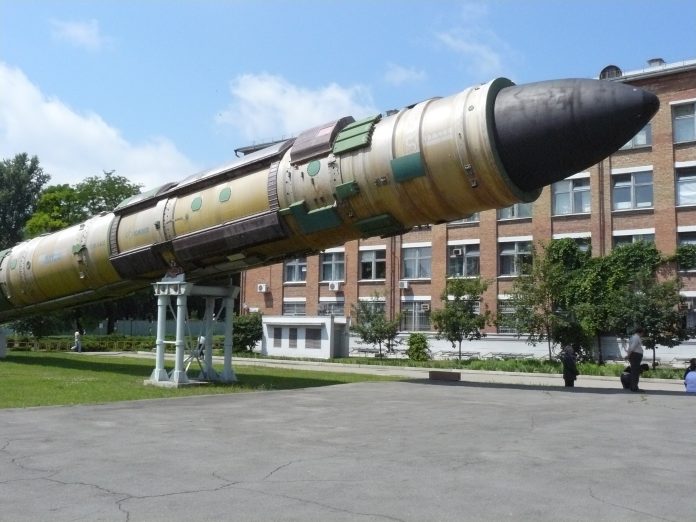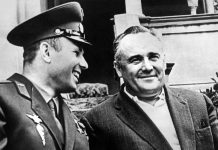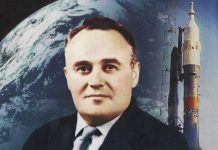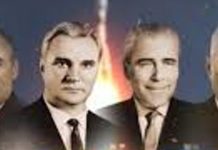Asif Azam Siddiqi is a professor of history with a specialization in the history of science and technology. When the Soviet archives opened in the 1990s, Siddiqi took advantage of it and wrote his first book Challenge to Apollo: The Soviet Union and the Space Race, 1945-1974 which The Wall Street Journal identified as “one of the five best books” on space exploration. The quotes below are taken from it: “In early February 1962, Korolev received an invitation from Khrushchev to attend a meeting of the top-secret Council of Defense at the holiday resort of Pitsunda. The entire high command of the Soviet defense industry, Communist Party, armed forces, and design bureaus were to attend, so it would not be an overstatement to suggest that it was perhaps the single most important policy meeting in the early Soviet space program, as the three main space designers – Korolev, Chelomey, and Yangel – vied for a slice of the cosmos…
Each of the three designers arrived at Pitsunda in late February armed with beautifully illustrated posters of their respective proposals and projects, intent on coercing the minds of the most powerful in the Soviet state. The first day of the meeting, February 22, was dedicated to briefings by several naval commanders, ending with a presentation by Chelomey. His performance was flawless. By the end, he had earned the green light to proceed with a new version of the UR-200 ICBM, as well as a completely new all-purpose ICBM/space launch vehicle/orbital bombardment system, the famous UR-500. Because of time limitations, Korolev’s speech was delayed to the second day.
In contrast to the smooth and sophisticated Chelomey, Korolev spoke in concise, choppy phrases. He showed his posters of the N1 to the assemblage, briefly reviewing the work done since the June 1960 decree. Emphasizing the delays and problems with funding, he casually brought up the need to raise the payload capability of the vehicle from its current forty tons to seventy-five tons. Calculations had shown that forty tons would be simply insufficient for missions to the Moon and the other planets…
Yangel spoke after Korolev and put a new twist on the entire situation. Yangel had always been somewhat of an “odd man out” in the Soviet space program. Although he had made quick progress in converting his old medium-range ballistic missiles, such as the R-12 and the R-14, into space launch vehicles, he had not expressed any explicit interest in the piloted space program. His primary domain was the development of Soviet ICBMs, and he seemed relatively content to limit his activities in the space arena to modest automated satellites for military purposes. Unlike Korolev’s flashy Zenit reconnaissance satellites, Yangel’s smaller spacecraft were for research on Earth’s ionosphere, meteoroid concentration in Earth orbit, cosmic rays, and Earth’s magnetic field areas that had indirect application to military goals. At the meeting in Pitsunda, Yangel proposed a massive new ICBM (the R-36), yet another orbital bombardment system (the R-36-0), and a heavy-lift space launch vehicle (the R-S6). The latter would have a launch mass of 1,400 tons and a lifting capability of forty tons to a 200-kilometer orbit, specifications remarkably similar to Korolev’s original NI plan .. Dazzled by the performance of Yangel’s design bureau in the rapid development of new high-performance military systems, the Soviet leadership, especially those in the Communist Party, were very receptive to the new proposals. All three of them were approved for further development.”
How independent Ukraine converted ICBM into Space Launch Vehicle >
The three chief designers mentioned above were all Ukrainians:
Sergei Korolev, Ukrainian born in Zhytomir, Ukraine >
Vladimir Chelomey, Ukrainian born in what is now Poland >
Mikhail Yangel, the chief designer of the missiles, was of Ukrainian descent, and not Russian as Wikipedia states. He was born in Siberia because his Ukrainian grandfather who had lived in the Chernigiv region of Ukraine was sent there by the Russians. The ‘Yangel’ last name most likely derives from Ukrainian word ‘yangol‘, ‘angel’ in English.










